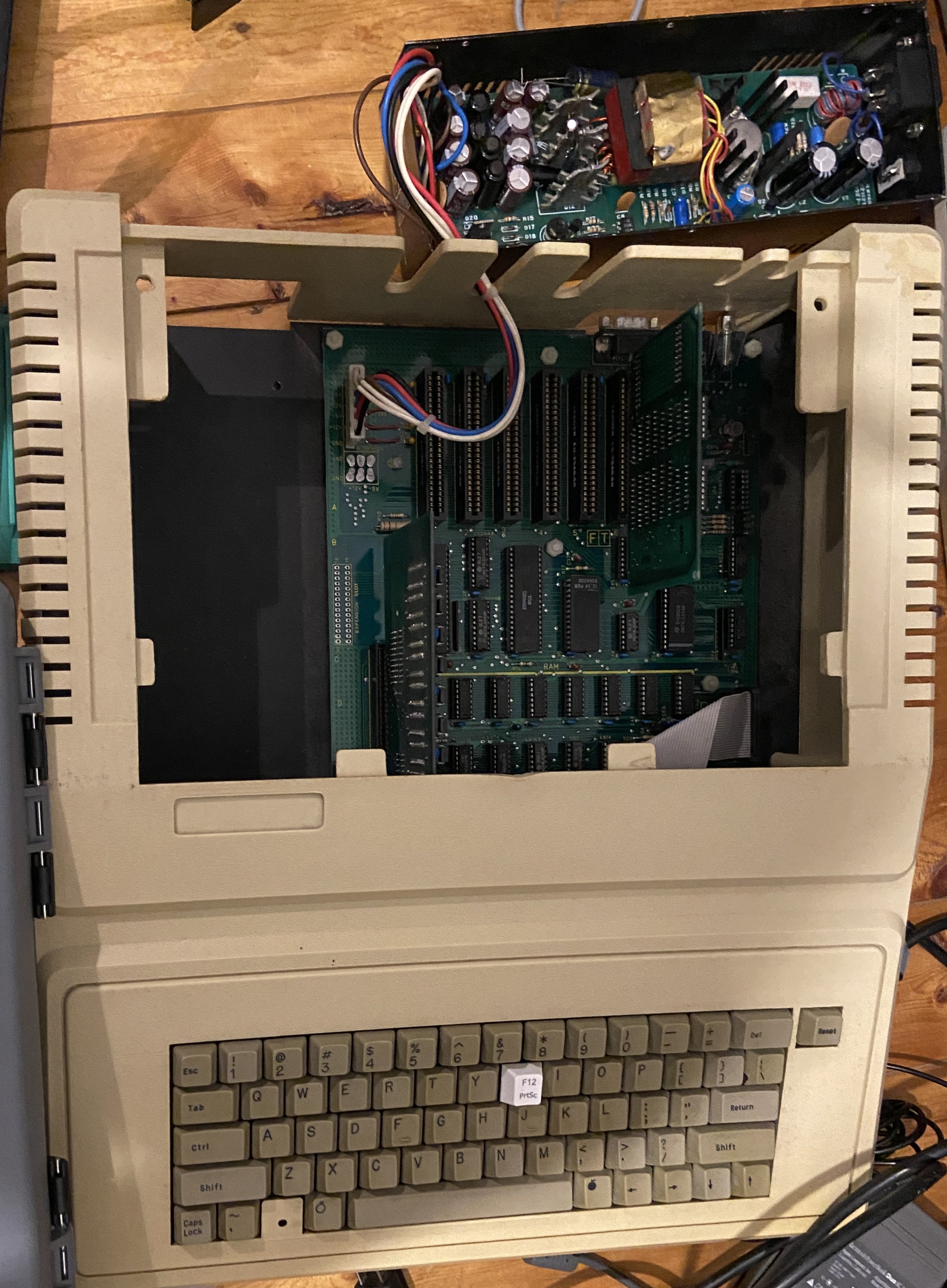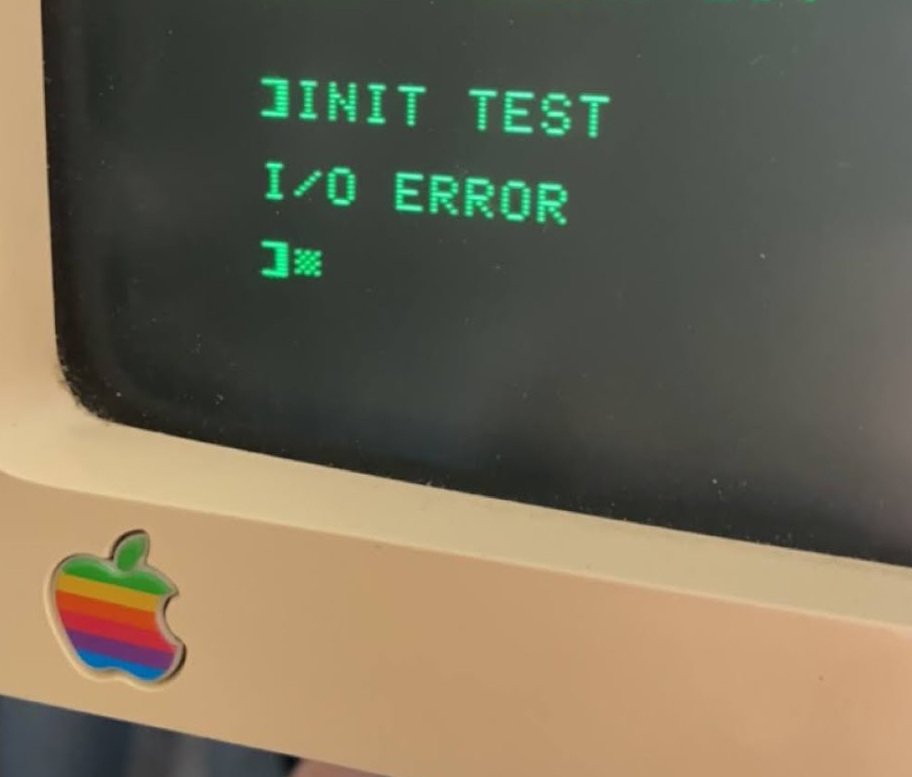Fixing a misbehaving Apple IIC floppy drive
I recently hosted a display table at the third annual World of Retro Computing in Kitchener, ON. I displayed my collection of Macintoshes and Mac laptops, arranged as a loose history of Apple computing.
Throughout the first day of the event, I heard (somewhat cheekily) from some of my fellow exhibitors that I was missing the entire Apple II line! While true that I did not have any II’s in my lineup, I thought I had a good excuse - my Apple IIe clone that I have at home had a bad power supply, and besides this was more of a Mac display.
Unfortunately, they got to me, and one of them was selling a IIC in good condition with a second IIC for parts included at a reasonable price. So it was that by 4PM, I was the proud owner of an Apple IIC.
The Apple IIC, for the uninitiated, was Apple’s attempt at a portable Apple II. It comes with a carry handle at the back, and is about as small as a computer with an integrated 5.25” floppy drive can be. It was released at roughly the same time as the original Macintosh, and was essentially a IIe with the usual expansion cards (2x serial, disk controller, mouse, printer) permanently installed.
This computer had that, but unreliably. My trouble started when I tried to write some floppies using ADTPro, a solution for passing data from a new computer to an Apple II. While I could often pass the data TO the machine (although not fully reliably), I could not format a floppy disk and save the data to it.
So I had two problems:
Cannot write floppy disks
Cannot reliably use serial connection
My next step after ADTPro was to try a FloppyEmu floppy emulator, which I could not get to work correctly, and through stupidly replugging while the computer was on, I fried. The external floppy drive I had plugged in also appeared to be damaged by this mistake.
So now I had four problems.
Cannot write floppy disks from internal drive
Cannot reliably use serial connection (a known issue for Apple IICs)
Cannot use external floppy drive
Cannot use FloppyEmu
Cutting my losses, I asked a friend from the local vintage computing group for some disks to get me started. They gave me some system disks, and a couple copies of MECC Computer Inspector. Running Computer Inspector yielded a report that the disk speed was OK, but the disk was running badly.
With this piece of information, I identified a few potential fixes I could tackle:
Clean the floppy drive
Swap floppy drive with donor machine
Rebuild/recap power supply
The easiest fix was to clean the drive, and so I broke out some 99% isopropyl alcohol and cleaned the head on the drive inside the main machine. Some amount of dirt came off, and the drive appeared to work, but after being on for 10 or so minutes, the drive failed to write, and made a loud sound:
That sound from the drive was somewhat new, so I swapped the donor machine’s drive and the main machine’s internal drive to no success. Finally, I went to the retro computing Stack Exchange so that I could see if I could get some help with diagnosis of the issue.
The kind folks there advised me that this sound was mostly normal, but indicated that the computer was having some trouble with reading data. The computer makes a more rapid sound when a DOS (e.g. ProDOS or DOS 3.3 in this case) is loaded, since these OSes can allow the drive to work faster, in much the same way as programs on other computers of the time (C64 in particular) can have faster disk access speeds with the right software.
Based on my experience with my IIe, I (mostly wrongly) assumed this was a power issue, figuring that if there was insufficient voltage going to the drive during reads, it would fail to read/write, and that the variable timing of the issue was heat-related. I bought a capacitor replacement kit for both the internal power supply and for the motherboard itself.
A quick note on IIC power: what is a single power supply in a standard Apple II, II+, or IIe, is two pieces in the IIC. The IIC has an AC adapter brick that steps down the voltage from mains voltage and rectifies it to DC, feeding a straight 12(ish)V into the computer, which has a small switching power supply inside it that can take anything from 9-20V and turn it into the various voltages required by different parts of the computer. The AC adapter brick (apparently) generally never acts up, although I will blame it for the disk issue in the next paragraph. The internal power supply, where all the electrolytic capacitors are, can occasionally act up, and is easily removed and repaired.
The caps arrived a few days later, and I spent an afternoon swapping all of the capacitors to very limited success. Figuring that maybe the problem came from the AC brick, I pulled out my oscilloscope and hooked it into the machine, across the switch. This resulted in a nice spark, so I swapped to using two probes with the math function to emulate a differential probe and tried again. Whenever the drive activated, there was a pretty significant voltage drop, and the mean voltage was going down the longer the computer was on, although not by much.
The oscilloscope setup. Note that a voltage drop is not currently happening.
Still, I thought this was the definite sign of a good diagnosis, and promptly chopped up a thrifted modern AC adapter and a dead AC brick from the donor machine to make a more modern power supply. This did not fix the issue.
A “modern” power supply. Heatshrinked connector to old cable in top left.
It was finally time for me to check the schematics (graciously provided thanks to the Woz back in the 80s) and figure out what else this issue could possibly come from.
The vast majority of the connections from the floppy drive to the computer go directly to one chip: the Integrated Woz Machine (IWM; circled on left above). This chip was made specifically for the Macintosh and the Apple IIC to replace the circuit that was an entire card for previous II models. It manages everything to do with floppy and other drives in the IIC, and does all of the data processing to read and write floppies.
Anyway, I decided to swap the socketed chips (the IOU, ROM, and MMU) with the donor machine. The ROM from the donor machine did not work (probably why it was a parts machine), but the IOU and the MMU appeared to have some positive effect. However, after 20 minutes of running, the drive was still acting up.
Finally, I sucked it up and decided to swap out the IWM. Since it was not socketed, this meant desoldering it from both the donor machine and the main machine. I put on a good podcast and got to work. With the soldering iron set to 320C, the solder came off without too much fuss. I took a lot of cooling breaks to avoid damaging the donor chip, and had to add a bit of solder for stubborn pins.
The previously-installed chip was a different story. Most pins desoldered just fine, but 3 pins in particular were very stubborn. It took a bit of force once all pins were clear, and it turned out one of the pins was digging into the side of the hole, and it ripped up part of a trace. After I soldered on the new socket (to avoid this problem in the future), I checked continuity, and the ripped trace turned out to be a problem. I ended up installing a “bodge wire” on the underside of the motherboard.
Third trace from left on the bottom is heavily damaged. Some amount of solder mask removed by heat and desoldering braid throughout.
After all of this, I plugged in the power supply, flipped the switch, and crossed my fingers…
It’s alive! The external drive is back to functioning, and a new FloppyEmu is on the way!
In the end, the IWM was to blame for my issues, or at least the loading issue. My suspicion is that there was a small issue there that got a lot worse when I live connected the FloppyEmu, and that nothing was wrong with the PSU or the socketed chips, but I guess I’ll never know for sure!
I hope my misadventures and mistakes are helpful to anyone else with an issue with their Apple IIC’s drive!








